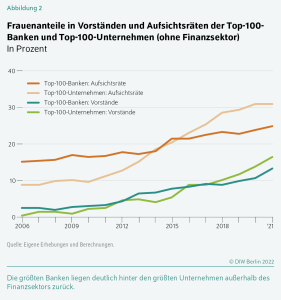The proportion of women on the management boards of the 200 companies with the highest sales in Germany (excluding the financial sector) was just under 15% in the fourth quarter of 2021. A year earlier, the figure was 11.5 %. This is the result of a study by the German Institute for Economic Research (DIW) in Berlin. Every year, the institute examines the representation of women on management boards and executive boards as well as on supervisory and administrative boards of the largest companies in Germany. The results are published in the form of the DIW Women Managers Barometer. The figures published here were researched from November 28 to December 7, 2021, and are based on companies' self-reporting on the internet, the annual reports for 2020, the Federal Gazette, and inquiries made by DIW Berlin to the companies.
Remarkable increase in the proportion of women on management boards
The total number of female board members in the top 200 companies rose by 38 to 139. There has never been such a sharp increase within one year as in 2021 for this indicator since the start of data collection in the Women Managers Barometer in 2006. However, the number of board members in this group of companies has also increased overall as a result of board enlargements. In the top 100 companies, which have consistently had slightly higher proportions of women on their boards since 2016, this has also risen sharply to over 16% in late fall 2021 (the year before it was just under 14%).
There was also a very strong increase in the proportion of women among the CEOs compared with previous years: In the group of top 200 companies, this proportion doubled year-on-year to 8% in the fourth quarter of 2021 (14 women instead of seven a year earlier). In the top 100 companies, there was also a significant upturn, with almost 7% women as CEOs (up from just over 4% previously). This corresponds to six instead of four women leading one of the top 100 companies in Germany in the fourth quarter of 2021.
Particularly strong increase at DAX companies
The increase in the proportion of women was particularly strong at DAX companies. Among the DAX-40 companies, 17.5% of board members were women. If we consider only the companies that were represented in the leading German index up to the changeover (DAX-30), the ratio was even higher at just under 19%, representing an increase of a good four percentage points over the previous year.
Proportion of women on supervisory boards hardly increases
The proportion of women on supervisory boards remains significantly higher than on executive boards, but developed less dynamically last year. In the group of the top 200 companies, however, the 30 percent mark was broken for the first time. The proportion of women on the supervisory boards of these companies rose by half a percentage point to a good 30%. By contrast, there was stagnation on the supervisory boards of the top 100 companies: As in the previous year, the proportion of women there in late fall 2021 was just under 31%.
By contrast, the number of women as supervisory board chairs increased - albeit still at a low level: at the top 200 companies from eight in 2020 to ten in 2021, corresponding to just over 6% of all supervisory board chairs. At the top 100 companies, there were five more women and thus one more chair of the supervisory board year-on-year - the corresponding figure in the fourth quarter of 2021 was just under 6%.
Financial sector lags a little behind
The DIW also looks specifically at the proportion of women in banks and insurance companies. Here, too, there were strong increases in the proportion of women on management boards, but hardly any increases on supervisory boards. In the financial sector, the proportion of women on management boards is slightly lower than in the top 200 companies in other sectors of the private sector (where it is just under 15%). In late fall 2021, it was a good 13% in the financial sector. This represents a year-on-year increase of almost three percentage points.
The share of women in the 60 largest insurance companies also rose to over 13%, up from just under 12% in the fall of 2020.
Among the CEOs of the 100 largest banks in Q4 2021, however, there were eight women, two fewer than a year earlier, and the corresponding share of women fell from just over 10% to just over 8%. Insurance companies, on the other hand, saw a sharp increase: five women as CEOs (a good 8%) were more than twice as many as in the previous year (two women and a good 3% respectively).
Financial sector with 25% quota of women on supervisory boards
The proportion of women on supervisory boards in the financial sector increased moderately last year. In the 100 largest banks, it increased by around one percentage point to just under 25%, while in the 60 largest insurance companies it also increased by one percentage point to a good 25%. There was also an increase in the proportion of women among the supervisory board chairmen at the insurance companies, from just under 7% to 10% (six women instead of four). In the 100 largest banks, there were still seven women among the supervisory board chairmen, corresponding to a share of just over 7%.
 Quelle: DIW Berlin
Quelle: DIW Berlin
Proportion of women on management boards increases in all banking groups, on supervisory boards only in public-sector banks
A comparison of the individual bank groups shows that the private banks have by far the highest proportion of women on their boards, with over 17%, followed by the cooperative banks with 12% and the public-sector banks with around 11%. In all three banking groups, the proportion of female board members increased significantly compared with the previous year - in contrast to the number of women as board chairmen: at both the public-sector and cooperative banks, it remained the same at four women and one woman respectively. At the private banks, the number of women chairing the management boards in late fall 2021 was even lower than a year earlier, at three.
Statutory quota helps to increase the proportion of women
The results suggest that statutory quotas help more than non-binding recommendations or voluntary commitments. In Germany in 2015, as part of the first Act for the equal participation of women and men in management positions in the private and public sectors (FüPoG I), a binding gender quota of 30% for the Supervisory Board was adopted for companies that are both listed on the stock exchange and subject to equal co-determination.
In fall 2021, this applied to 103 companies. In the group of top 200 companies, a comparison of the companies to which the supervisory board quota applies and those to which it does not shows a significantly stronger increase in the proportion of women in the quota companies, particularly in the period from 2014 to 2019. In these years, the proportion of women in the companies subject to the supervisory board quota increased by almost 15 percentage points (from around 20% to more than 34%), while in the companies to which the supervisory board quota does not apply it only increased by a good seven percentage points, from just under 16% to just over 23%. In the last two years, this group has caught up somewhat, but the proportion of women still lags well behind that of the quota companies (35%), most recently at just over 27%.
Initially, there were no statutory requirements in Germany for management boards in the FüPoG I adopted in 2015. These were only introduced as part of the Second Act for the Equal Participation of Women and Men in management positions in the private and public sectors (FüPoG II), which came into force in August 2021 and applies to Executive Board appointments from August 2022.
Among other things, this law stipulates that companies which are listed on the stock exchange, are subject to equal codetermination, and have a management board of at least four members must fill the next vacancy on the management board with a woman if the management board does not already include a woman. In contrast to the gender quota for supervisory boards, which is set at 30% in FüPoG I, FüPoG II only provides for a minimum participation and no fixed quota for management boards. This is understandable, as management boards are much smaller bodies than supervisory boards.
In March, Fondsfrauen will again specifically discuss the proportion of women in management bodies of the capital management companies examine and publish the results here.



